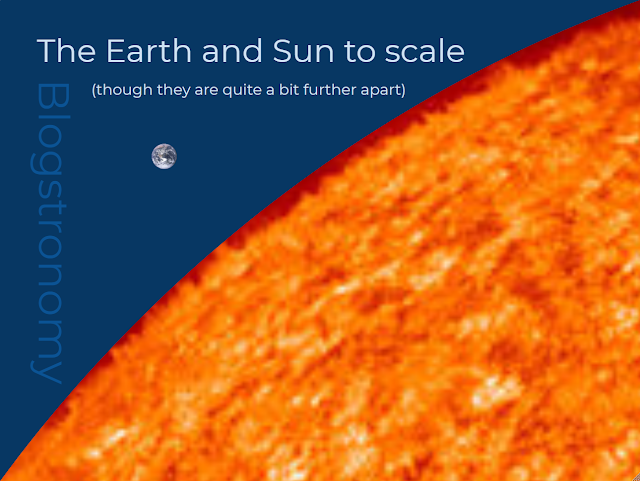Are some stars bigger than the Earth?
Question posed by Courtney.
Short answer: Yes!
In fact, most stars are bigger than the Earth. The diagram below compares the size of our sun with the sizes of the other planets in our solar system. The sun is much bigger than the Earth, and it isn't even a particularly large star.
 |
| The Earth and Sun to Scale by T. Briggs is licensed under CC BY-SA 4.0 |
Stars are made when the stuff that they are made of collapses and gets crushed together so hard that it starts burning through a process called nuclear fission. To make stuff collapse in on itself like this, you need a lot of gravity.
To get a lot of gravity, you need a lot of stuff. The Earth is made up of quite a lot of stuff, and therefore has a strong enough gravitational pull to keep you, cars, elephants, dogs and kettles on it. But it isn't made up of enough stuff for its gravity to crush all the stuff that it is made of together hard enough to start nuclear burning.How much stuff do you need for a star to form?
The smallest stars around, called brown dwarfs because they're quite small and don't give off much light, need about seven hundredths of the mass of our sun to be able to start burning helium in their cores. That might not sound like much, but to put it into perspective that's over twenty-thousand times the mass of the Earth! Even Jupiter only has around 318 times the mass of Earth.
The diagram above (nabbed from elsewhere- click the image to go there) shows the difference in size between our sun and the star OGLE-TR-122b, the smallest star yet discovered, and the similarity in size between that star and Jupiter, the largest planet in our solar system.
Most stars in the universe are brown or red dwarf stars, but they're difficult to see.
You said most stars are bigger than the Earth. Which ones aren't?
When stars use up all of their fuel, their gravitational pull causes them to collapse even further. When they cool down they can become a white dwarf, a neutron star or even a black hole (depending on their mass). All three of these can take up a smaller volume of space than the Earth, but contain much more mass.
Interesting info
- Depending on how massive stars are, different things happen when they run out of fuel: What happens when a star dies?
- A black hole can be formed when a really massive star dies.
- Our star, the sun, is about average as far as stars go: it isn't unusually big, small, bright or dim.
Have a question about this topic? Comment below! Got an astronomy related question of your own? Ask it here.



So glad there's enough gravity to keep my kettle grounded!! Haha! Need my coffee!
ReplyDeletei just seen a unique thing, there was a circle around the mooon very very intersting.
ReplyDeleteThat might make a good post... I don't suppose you got a photograph?
ReplyDeleteTHIS DID NOT HELP AT ALL DO NOT EVER MAKE ANOTHER WEBSITE!!! THERE IS NO INFORMATION EITHER! AND YOU THINK PEOPLE ARE GOING TO BELIEVE YOU!!! WELL THEN WHERE IS YOUR EVIDENCE!! EXACTLY!! TERRIBLE WEBSITE!! I HATE IT
ReplyDeleteThanks for your feedback. What would make it more useful to you?
DeleteHi there!
ReplyDeleteI am Gabriel Manor and I’ve been following your blog for a while now. I must admit that your blog spread a huge knowledge of astronomy and science throughout the world. Your blog posts have a lot in common with my work and expertise. I am a journalist with over 6 years of experience in various fields such as outer space, science, astronomy, etc. So I have perfect academic writing skills. The reason I’m reaching out is to ask if you are accepting guest posts. I have some really interesting ideas that might absolutely fit your content.
Here are a few topics that your readers will find valuable:
1) The largest star in the Universe
2) How does the Curiosity rover take pictures of itself?
3) The maximum distance a person moved from the Earth
4) Most of the solar system planets can be seen without a telescope
Anyway, I am always open to other ideas we can discuss. Please let me know about your decision. I look forward to hearing from you soon.
Hi Gabriel! I am interested in accepting guest posts but I can't see a way of getting in touch with you! You could use my question form to send me your email address privately (http://blogstronomy.blogspot.com/p/ask-question.html)
DeleteVery interesting , good job and thanks for sharing such a good blog.
ReplyDeleteDo have a look on my web. I had also work on the simillar topic :
neutron stars and black holes
neutron